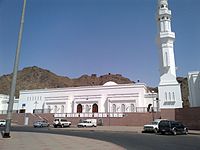
Back أثرية (عقيدة) Arabic Әҫәрилек Bashkir আসারি Bengali/Bangla Atharisme Catalan Athari German Teología tradicionalista (islam) Spanish Atharisme French Atsariyah ID അഥരി Malayalam Atharisme Dutch
| Part of a series on Sunni Islam |
|---|
|
|
| Part of a series on:
Salafi movement |
|---|
 |
|
|
Atharism or Atharī theology ([æl ʔæθæˈrɪj.jæ]; Arabic: الأثرية, romanized: al-Athariyya), otherwise referred to as Traditionalist theology or Scripturalist theology, is one of the main Sunni schools of Islamic theology which is more strict in adherence to the Quran and Sunnah.[a] it emerged as a school of theology in the late 8th century CE from the scholarly circles of Ahl al-Hadith, an early Islamic religious movement that rejected the formulation of Islamic doctrine derived from rationalistic Islamic theology (kalām) in favor of strict textualism in interpreting the Quran and the ḥadīth.[1][2] The name derives from "tradition" in its technical sense as a translation of the Arabic word athar.[1] Its adherents are referred to by several names such as "Ahl al-Athar", "Ahl al-Hadith", etc.[3][4][5]
Adherents of Atharī theology believe the zahir (literal) meaning of the Quran and the ḥadīth are the sole authorities in matters of belief (ʿaqīdah) and law (fiqh);[1] and that the use of rational disputation is forbidden, even if in verifying the truth.[6] Atharīs oppose the use of metaphorical interpretation regarding the anthropomorphic descriptions and attributes of God (ta'wil) and do not attempt to conceptualize the meanings of the Quran rationally[7] since they believe that their realities should be consigned to God alone (tafwid).[8] In essence, they assert that the literal meaning of the Quran and the ḥadīth must be accepted without a "how" (i.e. "Bi-la kayfa").
Atharī theology emerged among hadith scholars who eventually coalesced into a movement called Ahl al-Ḥadīth under the leadership of Ahmad ibn Hanbal (780–855).[9][b] In matters of faith, they were pitted against Muʿtazilites and other theological Islamic currents and condemned many points of their doctrine as well as the extreme rationalistic methods they used.[9] In the 10th century, al-Ashʿarī and al-Māturīdī found a middle ground between Muʿtazilite rationalism and Hanbalite literalism, using the rationalistic methods championed by Muʿtazilites to defend most tenets of the Atharī doctrine.[10] Although the mainly Hanbali scholars who rejected that synthesis were in the minority, their emotive, narrative-based approach to faith remained influential among the urban masses in some areas of the Muslim world, particularly in Abbasid Baghdad.[11]
Ashʿarism and Māturīdism are often regarded as the creeds of Sunni "orthodoxy", but Atharī theology has thrived alongside it by laying rival claims to be the orthodox Sunni faith.[12] In the modern era it has had a disproportionate impact on Islamic theology, having been appropriated by Wahhabi and other traditionalist Salafi currents, and spread well beyond the confines of the Hanbali school of jurisprudence.[13]
Cite error: There are <ref group=lower-alpha> tags or {{efn}} templates on this page, but the references will not show without a {{reflist|group=lower-alpha}} template or {{notelist}} template (see the help page).
- ^ a b c Abrahamov, Binyamin (2016) [2014]. "Part I: Islamic Theologies during the Formative and the Early Middle period – Scripturalist and Traditionalist Theology". In Schmidtke, Sabine (ed.). The Oxford Handbook of Islamic Theology. Oxford and New York: Oxford University Press. pp. 263–279. doi:10.1093/oxfordhb/9780199696703.013.025. ISBN 9780199696703. LCCN 2016935488.
- ^ Halverson (2010, p. 36). "The Atharis can thus be described as a school or movement led by a contingent of scholars (ulama), typically Hanbalite or even Shafi'ite, which retained influence, or at the very least a shared sentiment and conception of piety, well beyond the limited range of Hanbalite communities. This body of scholars continued to reject theology in favor of strict textualism well after Ash'arism had infiltrated the Sunni schools of law. It is for these reasons that we must delineate the existence of a distinct traditionalist, anti-theological movement, which defies strict identification with any particular madhhab, and therefore cannot be described as Hanbalite."
- ^ Azoulay, Rivka (2020). Kuwait and Al-Sabah: Tribal Politics and Power in an Oil State. London, UK: I.B. Tauris. p. 224. ISBN 978-1-8386-0505-6.
- ^ Vlad Ghiță, Adrian (2019). "Revivalismul islamic. Tendinţe înnoitoare" [Islamic Revivalism: Renewing trends]. Theology and Life. 40 (9–12): 143 – via The Central and Eastern European Online Library.
- ^ Bishara, Azmi (2022). "1: What is Salafism?". On Salafism: Concepts and Contexts. Stanford, California, USA: Stanford University Press. p. 2. ISBN 9781503631786. LCCN 2021061200.
- ^ Halverson (2010, p. 36).
- ^ Hoover, John (2020). "Early Mamlūk Ashʿarism against Ibn Taymiyya on the Nonliteral Reinterpretation (taʾwīl) of God's Attributes". In Shihadeh, Ayman; Thiele, Jan (eds.). Philosophical Theology in Islam: Later Ashʿarism East and West. Islamicate Intellectual History. Vol. 5. Leiden and Boston: Brill Publishers. pp. 195–230. doi:10.1163/9789004426610_009. ISBN 978-90-04-42661-0. ISSN 2212-8662. LCCN 2020008682. S2CID 219026357.
- ^ Halverson (2010, pp. 36–37).
- ^ a b Cite error: The named reference
Lapidus130was invoked but never defined (see the help page). - ^ Blankinship (2008, p. 53); Lapidus (2014, pp. 123–124)
- ^ Halverson (2010, p. 35)
- ^ Brown (2009, p. 180): "The Ash‘ari school of theology is often called the Sunni 'orthodoxy'. But the original ahl al-hadith, early Sunni creed from which Ash‘arism evolved has continued to thrive alongside it as a rival Sunni 'orthodoxy' as well."
- ^ Hoover (2014, p. 625)
© MMXXIII Rich X Search. We shall prevail. All rights reserved. Rich X Search